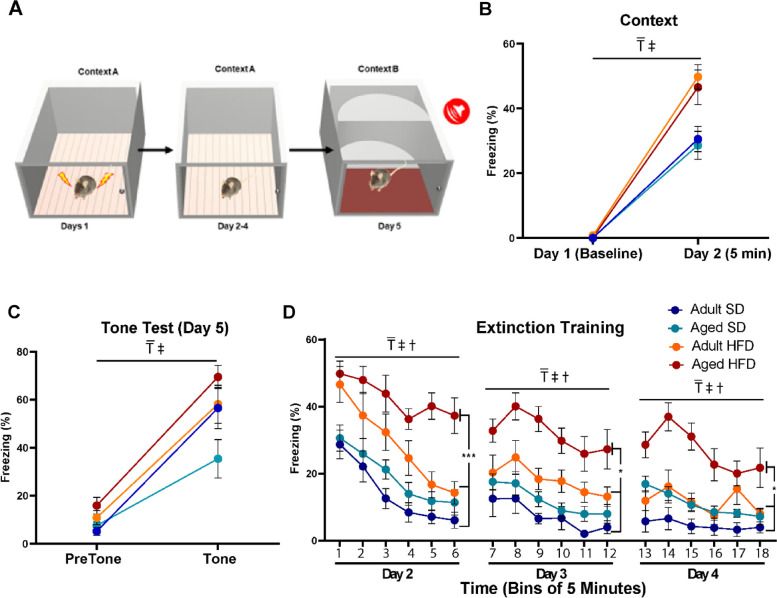Fig. 4.
HFD increases fear responses, particularly in aged mice. Aged HFD mice exhibit deficits in extinction learning (n = 10/group). (A) Fear conditioning paradigm. (B) Context test. Compared to baseline all mice displayed significant levels of freezing when returned to the training context on day 2 (3-way RM ANOVA; main effect of training F (1, 36) = 315.7; ₸, p < 0.0001). Freezing levels appeared to be modulated by diet (3-way RM ANOVA; main effect of diet F (1, 36) = 18.8; ‡, p < 0.0001) which was driven by the segregation of the two diet groups regardless of age at 24 h (1-way ANOVA F (3, 36) = 6.096, p = 0.0018). (C) Tone test. Mice were placed in a novel context and after a 180 s baseline period were exposed to the same tone used during training (the last 30 s of baseline and first 30 s of tone are presented. A 3-way repeated measures ANOVA revealed a main effect of training (F (1, 36) = 147.5 ₸, p < 0.0001). Freezing levels appeared to be modulated by diet (3-way RM ANOVA; main effect of diet F (1, 36) = 18.8; ‡, p < 0.0054) but this effect was not specific to group, although when freezing in response to tone was analyzed, there was a significant difference between mice in the Aged SD group and the Aged HFD group (1-way ANOVA F (3, 36) = 3.593,P = 0.0228 followed by Tukey post hoc comparison: adjusted p = 0.0141). (D) Extinction training. On days 2, 3 and 4 mice were returned to the original training context and freezing was measured for 30 min (presented here in 5 min bins). Across all three days there was a reduction in freezing in response to repeated context exposure (3-way RM ANOVA main effect of training: Day 2 F (1, 36) = 157.2, ₸, p < 0.0001; Day 3: F (1, 36) = 14.17; ₸, p = 0.0006; Day 4 F (1, 36) = 11.84; ₸, p = 0.0015) which was likely influenced by diet (3-way RM ANOVA main effect of diet: Day 2 F (1, 36) = 22.46, ₸, p < 0.0001; Day 3: F (1, 36) = 14.02; ₸, p = 0.0006; Day 4 F (1, 36) = 10.63; ₸, p = 0.0024) and age (3-way RM ANOVA main effect of age: Day 2 F (1, 36) = 4.963, ₸, p = 0.0322; Day 3: F (1, 36) = 6.750; ₸, p = 0.0135; Day 4 F (1, 36) = 16.03; ₸, p = 0.0003). This was especially evident on Day 2 where a training x diet x age interaction was observed (F (1, 36) = 4.963p = 0.0322). To more directly examine the effectiveness of extinction training a 1-way ANOVA was used to analyze freezing levels recorded in the final bin on each day. Across all three days there was a main effect of group (Day 2: F (3, 36) = 12.69, p < 0.0001; Day 3: F (3, 36) = 7.524, p = 0.0005; Day 4: F (3, 36) = 5.530 P = 0.0032). This effect appears to be a function of mice in the Aged HFD group which exhibited significantly more freezing as compared to the other 3 groups (Tukey’s multiple comparisons test *** p < 0.001, * p < 0.05). All data are presented as mean ± SEM

